A Maximum Power Point Tracking Method Based on a Modified Grasshopper Algorithm Combined with Incremental Conductance
Abstract
1. Introduction
2. Review of Grasshopper Optimization Algorithm and Incremental Conductance
2.1. Review of Grasshopper Optimization Algorithm
2.2. Review of Incremental Conductance (IC)
3. Proposed Method
3.1. ECGOA with Arithmetic Mean
3.2. Combination of the ECGOA with Arithmetic Mean and IC
3.3. Tracking Example of the Proposed Method
4. Simulation Result
4.1. Static Case Studies
- In curve 1, the proposed method is 3.96% faster than MFA and 16.02% faster than PSO
- In curve 2, the proposed method is 45.55% faster than MFA and 61.36% faster than PSO
- In curve 3, the proposed method is 47.28% faster than MFA and 63.58% faster than PSO
- In curve 4, the proposed method is 17.59% faster than MFA and 50.31% faster than PSO
- In curve 5, the proposed method is 20.30% faster than MFA and 32.91% faster than PSO
- In curve 6, the proposed method is 44.67% faster than MFA and 59.71% faster than PSO
4.2. Dynamic Case Studies
5. Conclusions
Author Contributions
Funding
Acknowledgments
Conflicts of Interest
References
- Du, E.; Zhang, N.; Hodge, B.M.; Wang, Q.; Kang, C.; Kroposki, B.; Xia, Q. The Role of Concentrating Solar Power toward High Renewable Energy Penetrated Power Systems. IEEE Trans. Power Syst. 2018, 33, 6630–6641. [Google Scholar] [CrossRef]
- Kannan, N.; Vakeesan, D. Solar energy for future world: A review. Renew. Sustain. Energy Rev. 2016, 62, 1092–1105. [Google Scholar] [CrossRef]
- Romero-Cadaval, E.; Spagnuolo, G.; Franquelo, L.G.; Ramos-Paja, C.A.; Suntio, T.; Xiao, W.M. Grid-Connected Photovoltaic Generation Plants: Components and Operation. IEEE Ind. Electron. Mag. 2013, 7, 6–20. [Google Scholar] [CrossRef]
- Jiang, R.; Han, Y.; Zhang, S. Wide-range, high-precision and low-complexity MPPT circuit based on perturb and observe algorithm. Electron. Lett. 2017, 53, 1141–1142. [Google Scholar] [CrossRef]
- Hsieh, G.; Hsieh, H.; Tsai, C.; Wang, C. Photovoltaic Power-Increment-Aided Incremental-Conductance MPPT With Two-Phased Tracking. IEEE Trans. Power Electron. 2013, 28, 2895–2911. [Google Scholar] [CrossRef]
- Shao, R.; Wei, R.; Chang, L. A Multi-stage MPPT Algorithm for PV Systems Based on Golden Section Search Method. In Proceedings of the 2014 IEEE Applied Power Electronics Conference and Exposition—APEC, Fort Worth, TX, USA, 16–20 March 2014; pp. 676–683. [Google Scholar]
- Lavado Villa, L.F.; Ho, T.; Crébier, J.; Raison, B. A Power Electronics Equalizer Application for Partially Shaded Photovoltaic Modules. IEEE Trans. Ind. Electron. 2013, 60, 1179–1190. [Google Scholar] [CrossRef]
- Abdalla, I.; Corda, J.; Zhang, L. Multilevel DC-Link Inverter and Control Algorithm to Overcome the PV Partial Shading. IEEE Trans. Power Electron. 2013, 28, 14–18. [Google Scholar] [CrossRef]
- Femia, N.; Lisi, G.; Petrone, G.; Spagnuolo, G.; Vitelli, M. Distributed maximum power point tracking of photovoltaic arrays: Novel approach and system analysis. IEEE Trans. Ind. Electron. 2008, 55, 2610–2621. [Google Scholar] [CrossRef]
- Liu, Y.; Pang, Z.; Cheng, Z. Research on an adaptive solar photovoltaic array using shading degree model-based reconfiguration algorithm. In Proceedings of the 2010 Chinese Control and Decision Conference, Xuzhou, China, 26–28 May 2010; pp. 2356–2360. [Google Scholar]
- Ramana, V.V.; Jena, D. Maximum power point tracking of PV array under non-uniform irradiance using artificial neural network. In Proceedings of the 2015 IEEE International Conference on Signal Processing, Informatics, Communication and Energy Systems (SPICES), Calicut, India, 19–21 February 2015; pp. 1–5. [Google Scholar]
- Biabani, M.A.K.A.; Ahmed, F. Maximum power point tracking of photovoltaic panels using perturbation and observation method and fuzzy logic control based method. In Proceedings of the 2016 International Conference on Electrical, Electronics, and Optimization Techniques (ICEEOT), Tamil Nadu, India, 3–5 March 2016; pp. 1614–1620. [Google Scholar]
- Korodi, A. Building a Knowledge base to obtain the maximum power point for a PV panel. In Proceedings of the 2012 IEEE International Conference on Control Applications, Zhangjiajie, China, 25–27 March 2012; pp. 1098–1103. [Google Scholar]
- Chen, L.-R.; Tsai, C.-H.; Lin, Y.-L.; Lai, Y.-S. A biological swarm chasing algorithm for tracking the PV maximum power point. IEEE Trans. Energy Convers. 2010, 25, 484–493. [Google Scholar] [CrossRef]
- Miyatake, M.; Veerachary, M.; Toriumi, F.; Fujii, N.; Ko, H. Maximum power point tracking of multiple photovoltaic arrays: A PSO approach. IEEE Trans. Aerosp. Electron. Syst. 2011, 47, 367–380. [Google Scholar] [CrossRef]
- Titri, S.; Larbes, C.; Toumi, K.Y.; Benatchba, K. A new MPPT controller based on the Ant colony optimization algorithm for Photovoltaic systems under partial shading conditions. Appl. Soft Comput. 2017, 58, 465–479. [Google Scholar] [CrossRef]
- Ahmed, J.; Salam, Z. A Maximum Power Point Tracking (MPPT) for PV system using Cuckoo Search with partial shading capability. Appl. Energy 2014, 119, 118–130. [Google Scholar] [CrossRef]
- Sundareswaran, K.; Peddapati, S.; Palani, S. MPPT of PV systems under partial shaded conditions through a colony of flashing fireflies. IEEE Trans. Energy Convers. 2014, 29, 463–472. [Google Scholar]
- Teshome, D.F.; Lee, C.H.; Lin, Y.W.; Lian, K.L. A Modified Firefly Algorithm for Photovoltaic Maximum Power Point Tracking Control Under Partial Shading. IEEE J. Emerg. Sel. Top. Power Electron. 2017, 5, 661–671. [Google Scholar] [CrossRef]
- Tey, K.S.; Mekhilef, S.; Seyedmahmoudian, M. Implementation of Bat Algorithm as Maximum Power Point Tracking Technique for Photovoltaic System under Partial Shading Conditions. In Proceedings of the IEEE Energy Conversion Congress and Exposition (ECCE), Portland, OR, USA, 23–27 September 2018; pp. 2531–2535. [Google Scholar]
- Liao, C.Y.; Subroto, R.K.; Millah, I.S.; Lian, K.L.; Huang, W.T. An improved bat algorithm for more efficient and faster maximum power point tracking for a photovoltaic system under partial shading conditions. IEEE Access 2020, 8, 96378–96390. [Google Scholar] [CrossRef]
- Mohanty, S.; Subudhi, B.; Ray, P.K. A New MPPT design using grey wolf optimization technique for photovoltaic system under partial shading conditions. IEEE Trans. Sustain. Energy 2016, 7, 181–188. [Google Scholar] [CrossRef]
- Sundareswaran, K.; Sankar, P.; Nayak, P.S.R.; Simon, S.P.; Palani, S. Enhanced energy output from a PV system under partial shaded conditions through artificial bee colony. IEEE Trans. Sustain. Energy 2015, 6, 198–209. [Google Scholar] [CrossRef]
- Bhukya, L.; Nandiraju, S. A novel photovoltaic maximum power point tracking technique based on grasshopper optimized fuzzy logic approach. Int. J. Hydrog. Energy 2020, 45, 9416–9427. [Google Scholar] [CrossRef]
- Mansoor, M.; Mirza, A.F.; Ling, Q.; Javed, M.Y. Novel grass hopper optimization based MPPT of PV systems for complex partial shading conditions. Sol. Energy 2020, 198, 499–518. [Google Scholar] [CrossRef]
- Saremi, S.; Mirjalili, S.; Lewis, A. Grasshopper optimization algorithm: Theory and application. Adv. Eng. Softw. 2017, 105, 30–47. [Google Scholar] [CrossRef]
- Saxena, A.; Shekhawat, S.; Kumar, R. Application and Development of Enhanced Chaotic Grasshopper Optimization Algorithms. Model. Simul. Eng. 2018, 2018, 1–14. [Google Scholar] [CrossRef]
- Seyedmahmoudiana, M.; Horan, B.; Soon, T.K.; Rahmani, R.; Oo, A.M.T.; Mekhilef, S.; Stojcevskie, A. State of the art artificial intelligence-based MPPT techniques for mitigating partial shading effects on PV systems—A review. Renew. Sustain. Energy Rev. 2016, 64, 435–455. [Google Scholar] [CrossRef]
- Nugraha, D.A.; Lian, K.L.; Suwarno. A Novel MPPT Method Based on Cuckoo Search Algorithm and Golden Section Search Algorithm for Partially Shaded PV System. Can. J. Electr. Comput. Eng. 2019, 42, 173–182. [Google Scholar] [CrossRef]

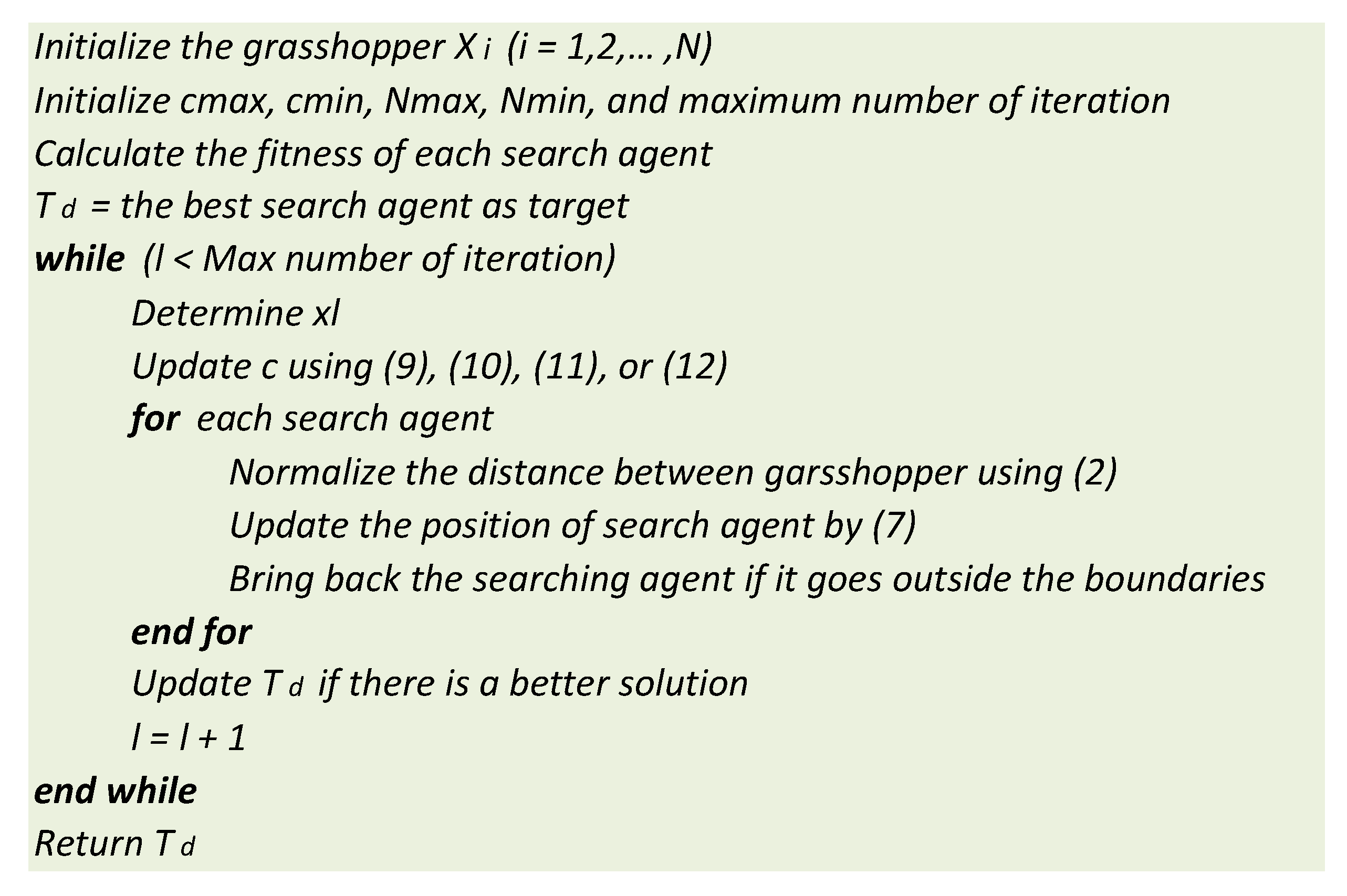
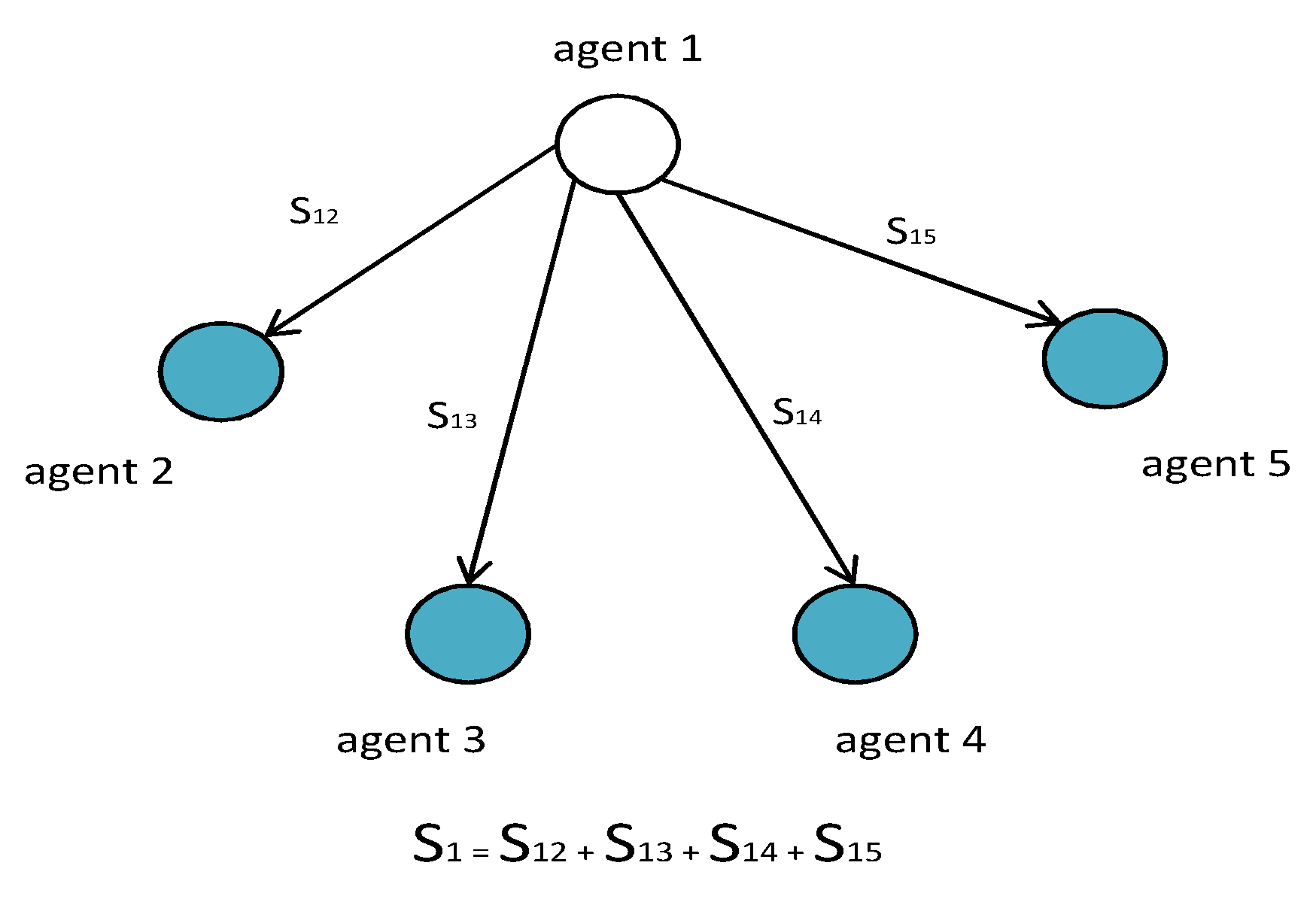
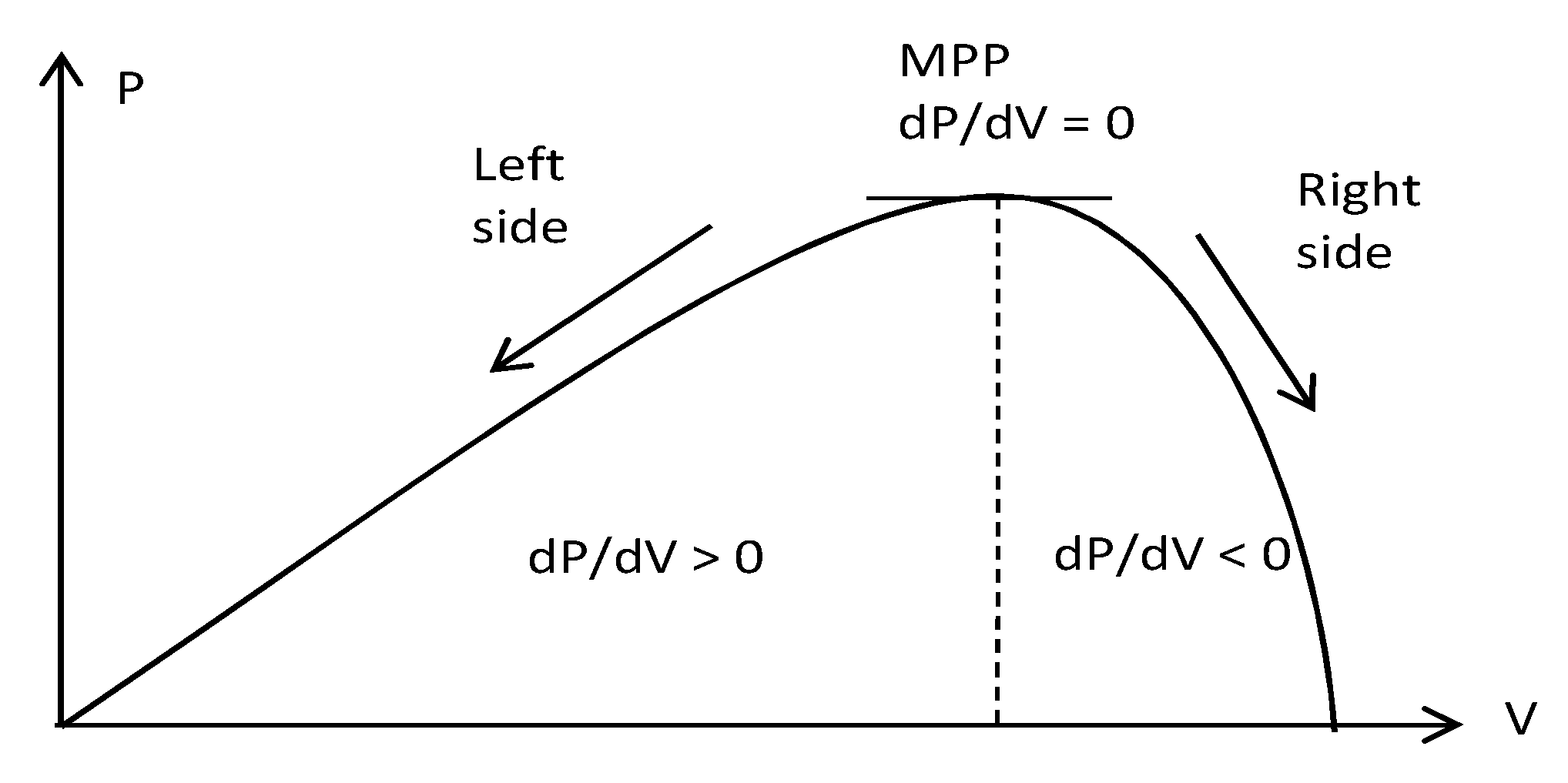
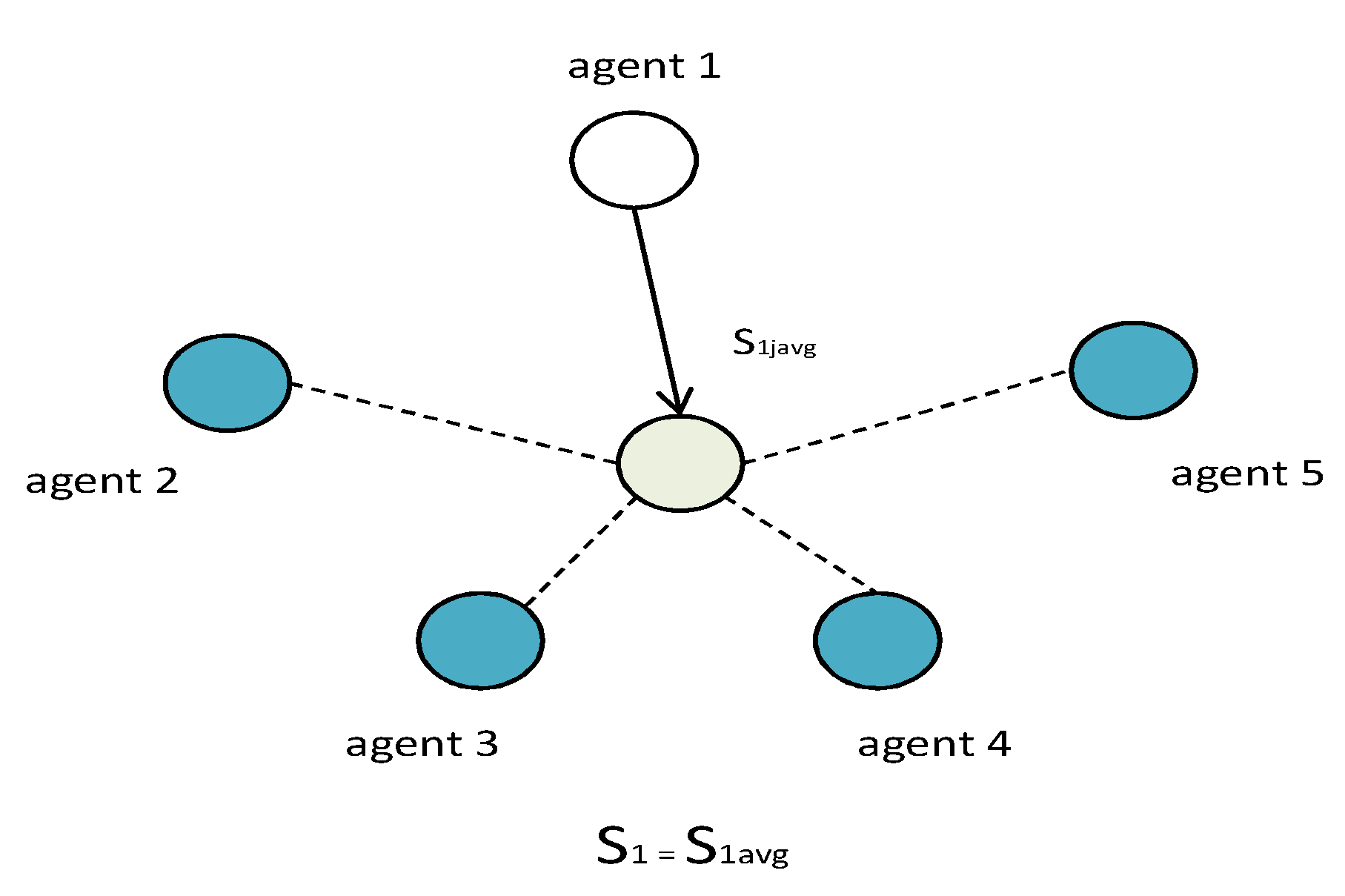
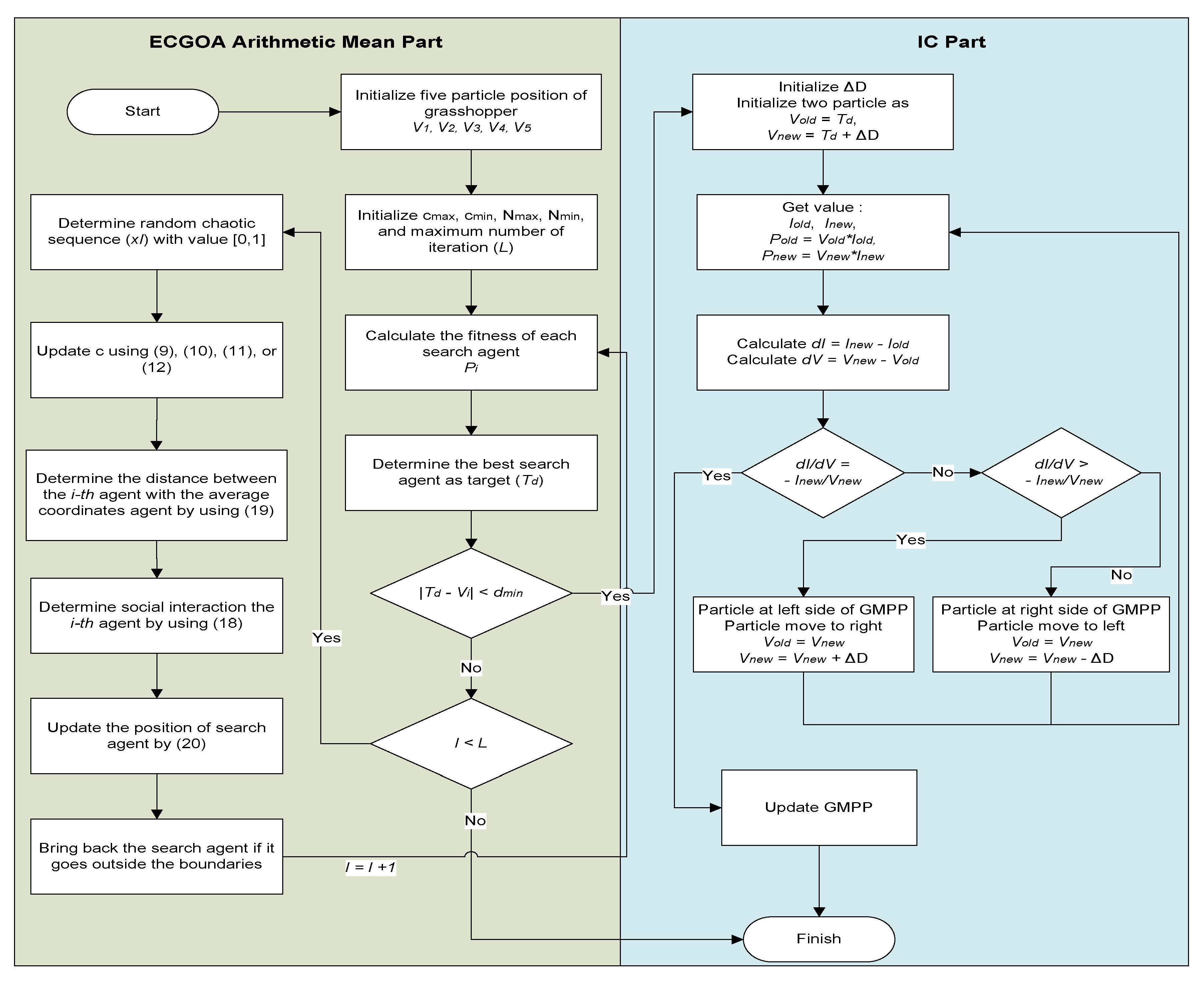
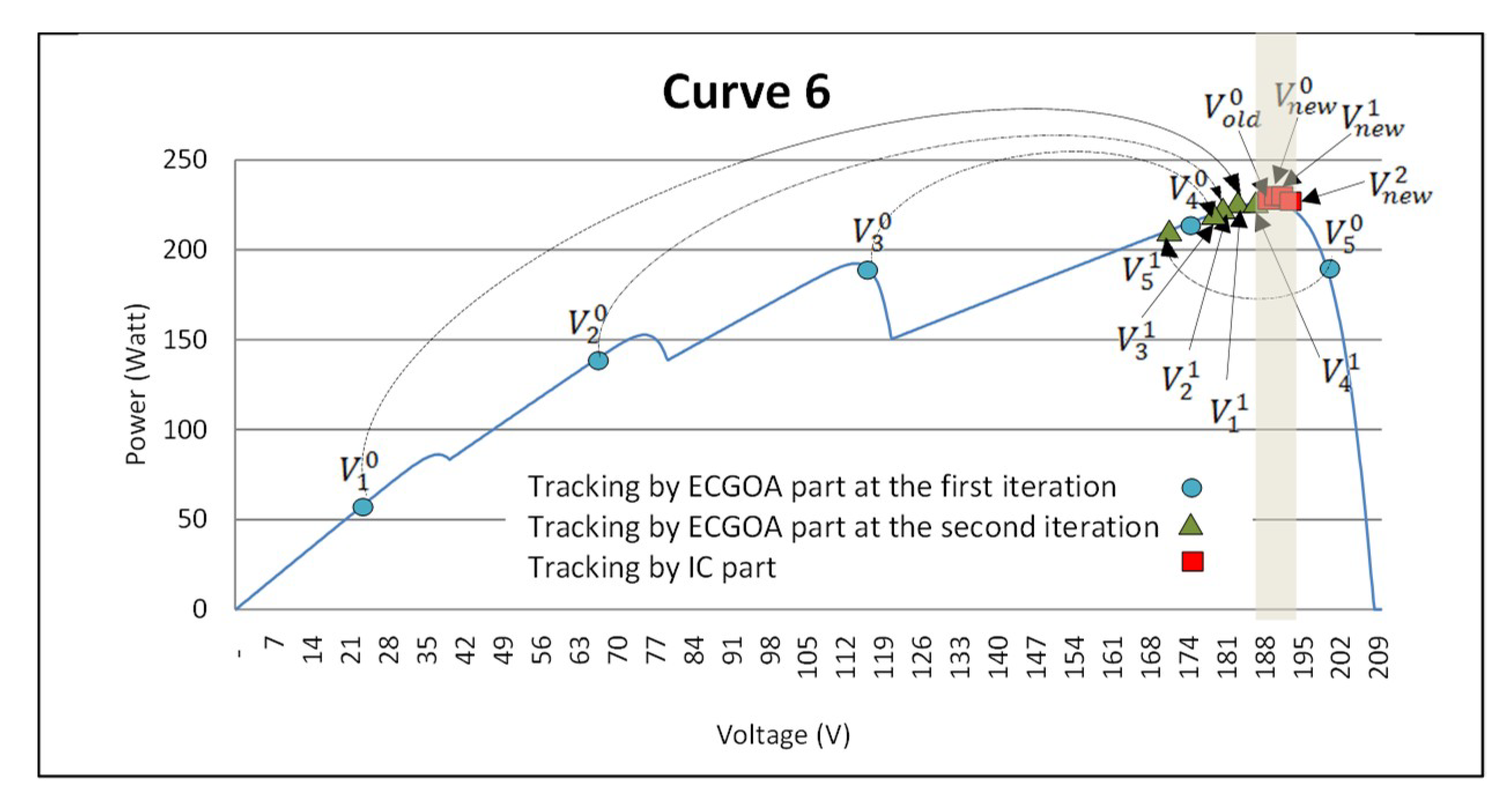
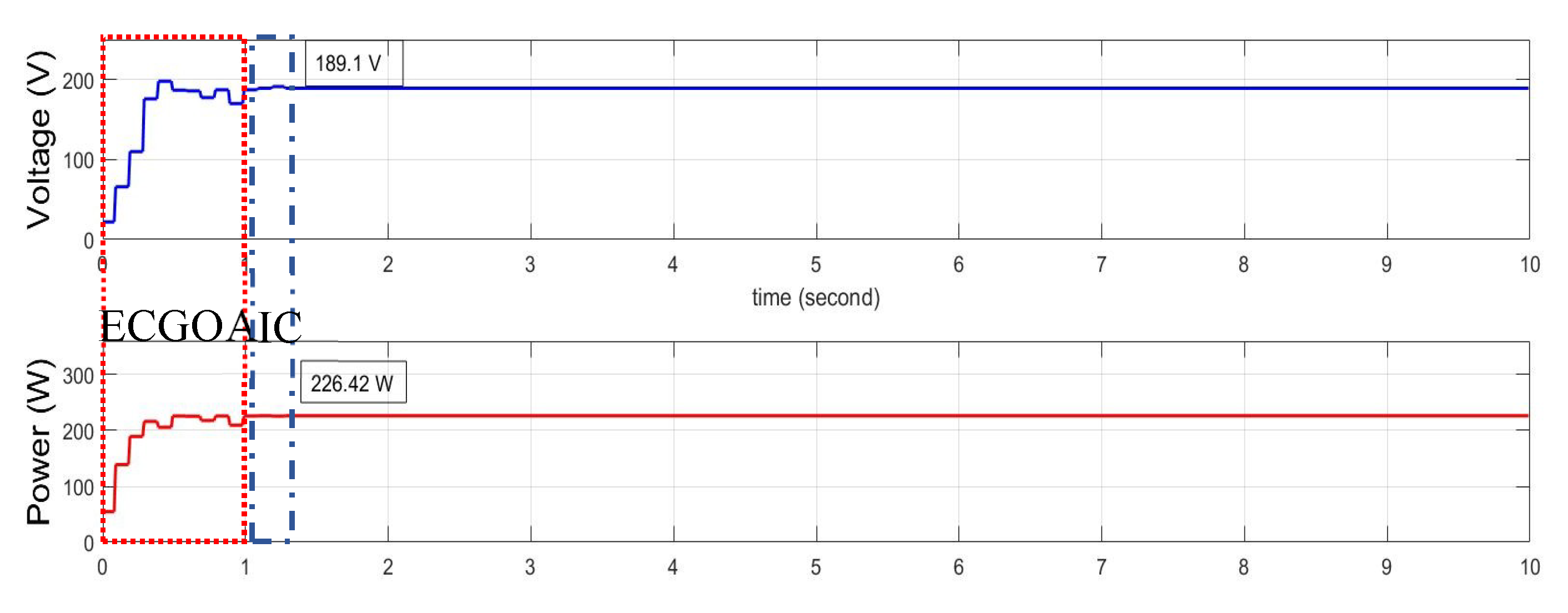


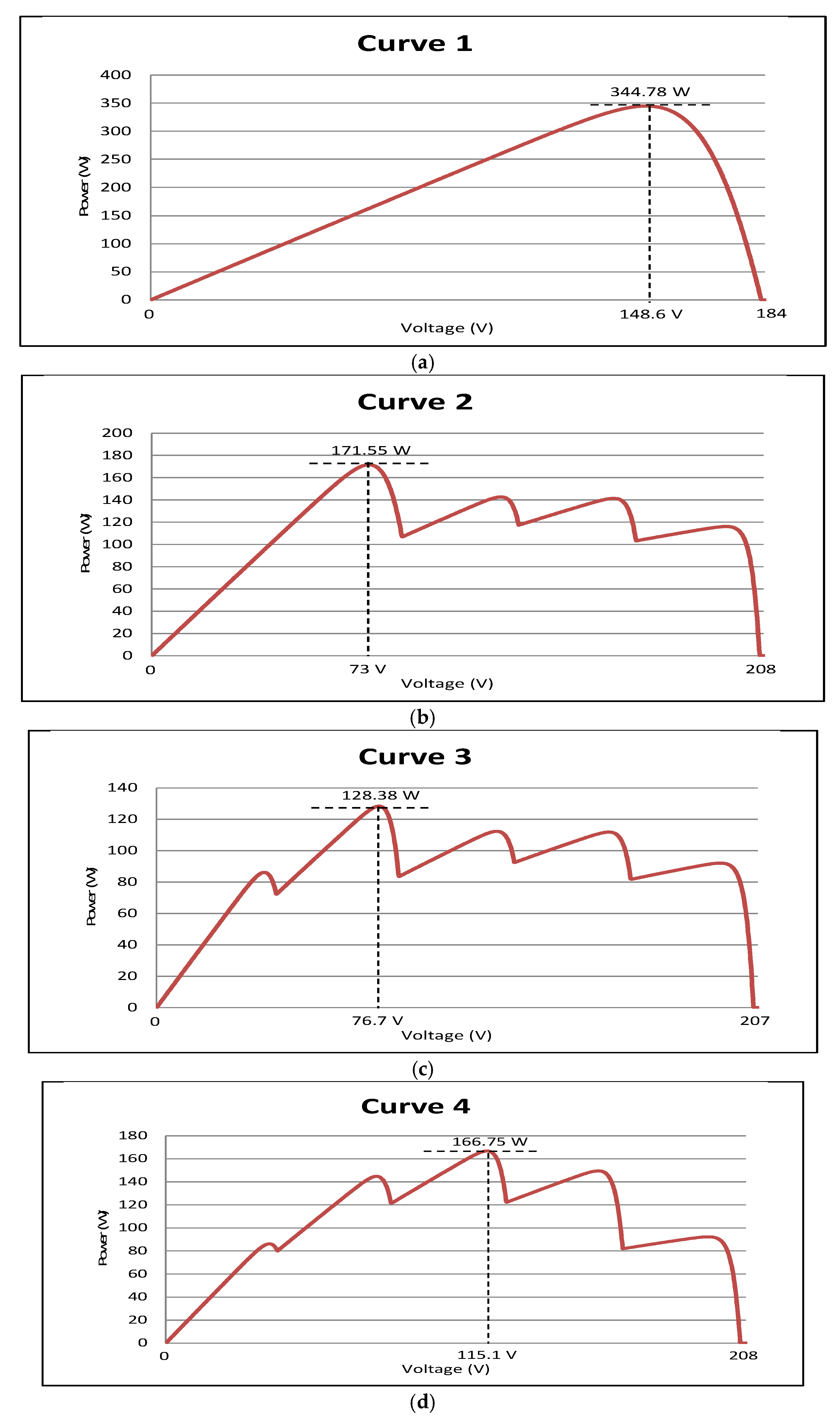
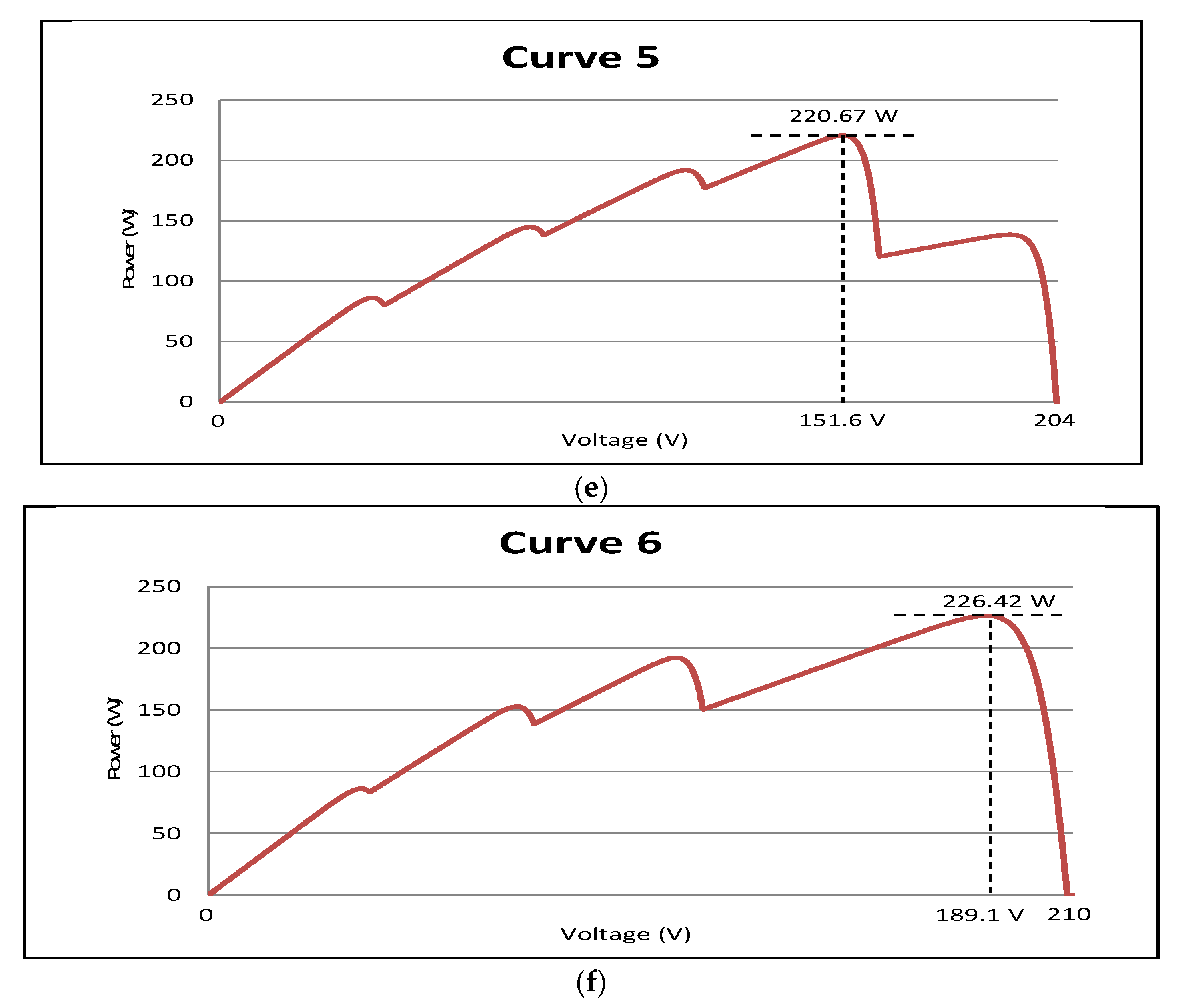
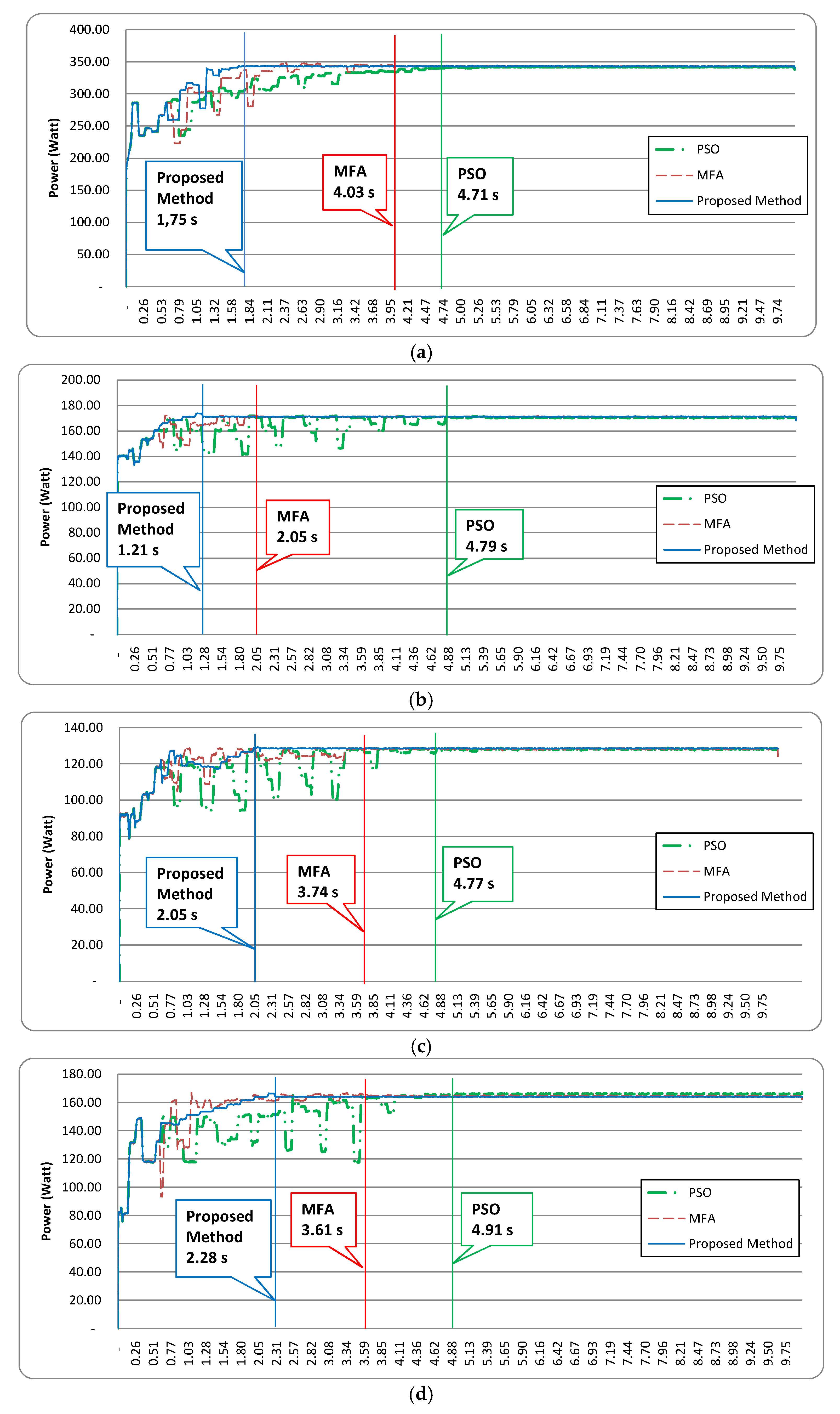
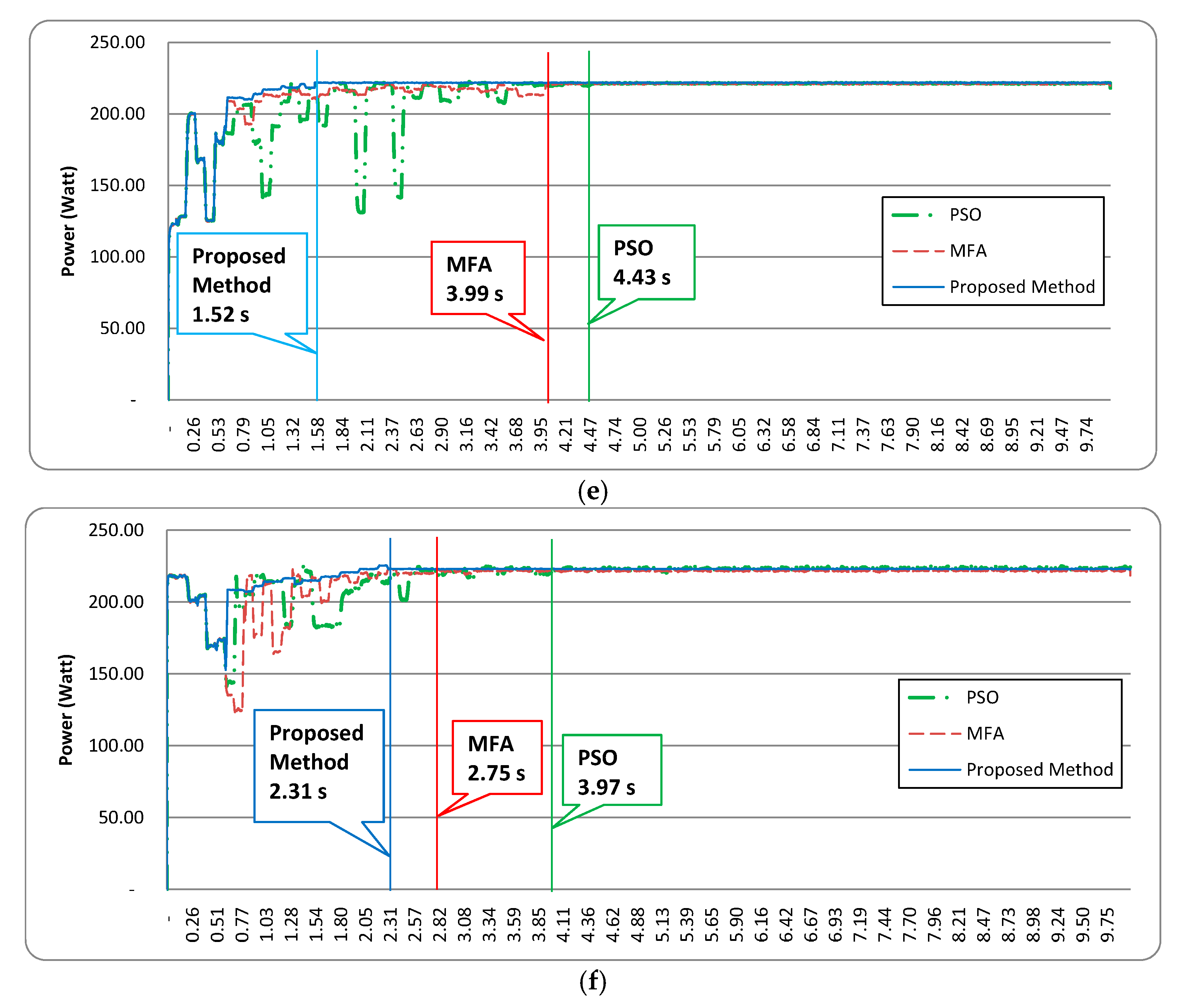
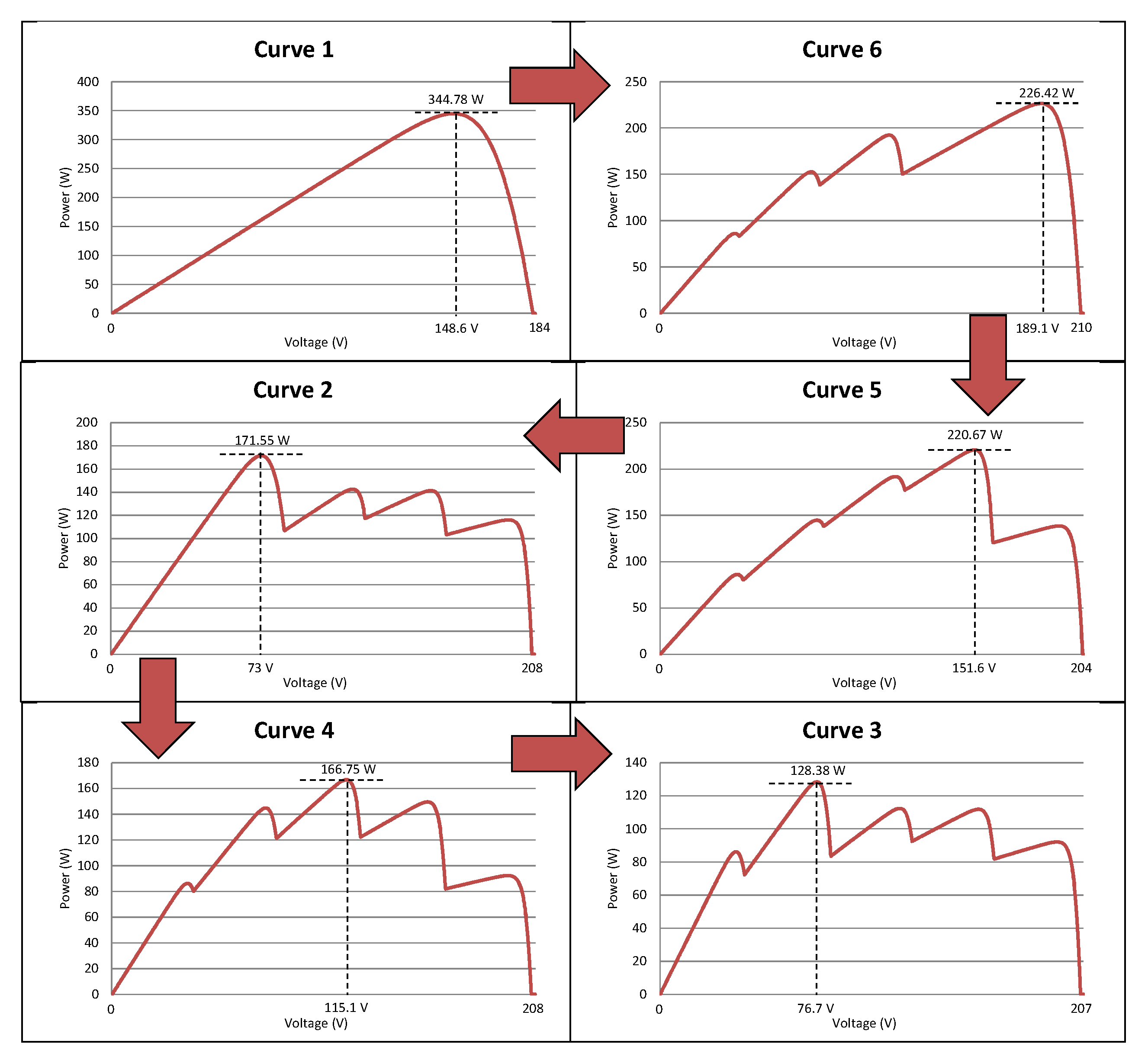
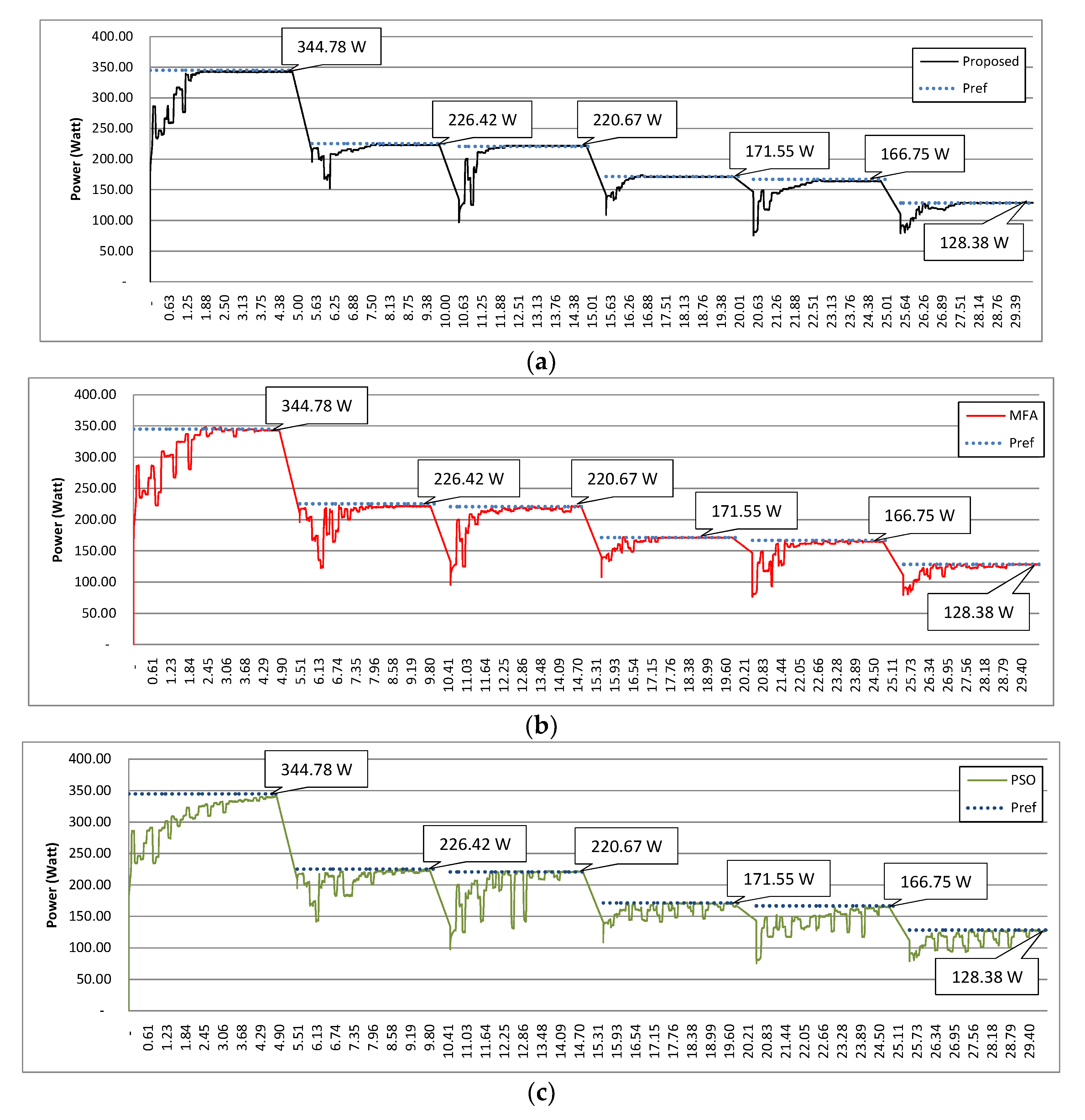
| Particles | Iteration Cycle | Note | |
|---|---|---|---|
| 0-th | 1st | ||
| Grasshopper No 1 | * All transition requirements are satisfied after the first iteration cycle: * Best solution from ECGOA ; * The transition from ECGOA to IC is done by taking the value of as on IC | ||
| Grasshopper No 2 | |||
| Grasshopper No 3 | |||
| Grasshopper No 4 | * Best Target | * Best Target | |
| Grasshopper No 5 | |||
| Parameter | IC Iterative Step | |||
|---|---|---|---|---|
| 1st | 2nd | 3rd | 4th | |
| 187.3 V | 187.3 V | 189.3 V | 191.3 V | |
| 226.1 W | 226.1 W | 226.4 W | 225.6 W | |
| - | 189.3 V | 191.3 V | 189.3 V | |
| - | 226.4 W | 225.6 W | 226.4 V | |
| 187.3 V | 189.3 V | 189.3 V | 189.3 V | |
| 226.1 V | 226.4 V | 226.4 V | 226.4 V | |
| No | Method | Parameters |
|---|---|---|
| 1. | PSO | ; ; |
| 2. | MFA | ; ; ; |
| 3. | Proposed Method | ; ; ; ; ; |
| No | Algorithm | Curve 1 | Curve 2 | Curve 3 | Curve 4 | Curve 5 | Curve 6 |
|---|---|---|---|---|---|---|---|
| 1. | Proposed Method | 99.94 ± 0.02 | 99.97 ± 0.05 | 99.95 ± 0.03 | 99.95 ± 0.08 | 99.69 ± 0.41 | 99.69 ± 0.07 |
| 2. | MFA | 99.92 ± 0.06 | 99.91 ± 0.15 | 99.94 ± 0.01 | 99.89 ± 0.28 | 99.65 ± 0.17 | 99.93 ± 0.09 |
| 3. | PSO | 99.84 ± 0.18 | 99.76 ± 0.04 | 99.57 ± 0.28 | 99.31 ± 0.01 | 99.35 ± 0.37 | 99.75 ± 0.07 |
| No | Algorithm | Curve 1 | Curve 2 | Curve 3 | Curve 4 | Curve 5 | Curve 6 |
|---|---|---|---|---|---|---|---|
| 1. | Proposed Method | 3.88 ± 0.13 | 1.53 ± 0.09 | 1.65 ± 0.11 | 2.39 ± 0.11 | 2.63 ± 0.08 | 1.66 ± 0.06 |
| 2. | MFA | 4.04 ± 0.40 | 2.81 ± 0.30 | 3.13 ± 0.95 | 2.90 ± 0.57 | 3.30 ± 0.79 | 3.00 ± 0.29 |
| 3. | PSO | 4.62 ± 0.31 | 3.96 ± 0.83 | 4.53 ± 1.09 | 4.81 ± 1.37 | 3.92 ± 0.40 | 4.12 ± 0.38 |
| No. | Method | Curve 1–6–5–2–4–3 |
|---|---|---|
| 1. | Proposed Method | 93.70% |
| 2. | MFA | 92.29% |
| 3. | PSO | 89.52% |
© 2020 by the authors. Licensee MDPI, Basel, Switzerland. This article is an open access article distributed under the terms and conditions of the Creative Commons Attribution (CC BY) license (http://creativecommons.org/licenses/by/4.0/).
Share and Cite
Wijaya, B.H.; Subroto, R.K.; Lian, K.L.; Hariyanto, N. A Maximum Power Point Tracking Method Based on a Modified Grasshopper Algorithm Combined with Incremental Conductance. Energies 2020, 13, 4329. https://doi.org/10.3390/en13174329
Wijaya BH, Subroto RK, Lian KL, Hariyanto N. A Maximum Power Point Tracking Method Based on a Modified Grasshopper Algorithm Combined with Incremental Conductance. Energies. 2020; 13(17):4329. https://doi.org/10.3390/en13174329
Chicago/Turabian StyleWijaya, Bustani Hadi, Ramadhani Kurniawan Subroto, Kuo Lung Lian, and Nanang Hariyanto. 2020. "A Maximum Power Point Tracking Method Based on a Modified Grasshopper Algorithm Combined with Incremental Conductance" Energies 13, no. 17: 4329. https://doi.org/10.3390/en13174329
APA StyleWijaya, B. H., Subroto, R. K., Lian, K. L., & Hariyanto, N. (2020). A Maximum Power Point Tracking Method Based on a Modified Grasshopper Algorithm Combined with Incremental Conductance. Energies, 13(17), 4329. https://doi.org/10.3390/en13174329





